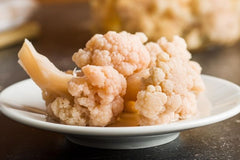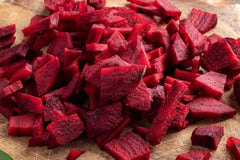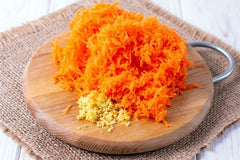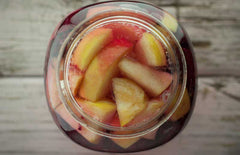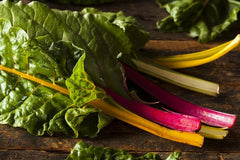Confused About Fermented Foods? Start Here

For thousands of years, people from around the world have known that fermented foods were incredible – even without the science.
Now with the benefit of scientific knowledge, we’re finally beginning to understand just why they are so amazing.
What’s going on in our gut?
Recently, it has been discovered that something is going on in our intestines (our gut) that is extremely important for our health and well-being:
A vast community of organisms, and in particular bacteria, are living there, having a massive impact on our health.
This community, or ecosystem, is sometimes called our ‘gut flora’ or our ‘gut microbiome’.
The bacteria are often referred to as either ‘good’ or ‘bad’ bacteria, although it is not always as clear cut as that suggests. It’s often more about balance.
‘Good’ bacteria
Basically we need plenty of ‘good’ bacteria, so-called probiotics (pro: for, and biotic: life). These serve us well, performing vital and beneficial tasks, like:
- Breaking down some of our food––including certain carbs––and releasing its energy for us to use
- Making large amounts of our neurotransmitters––chemicals that act as messengers between our brain and our body––which play essential roles in how our body functions
- Making certain vitamins and amino acids
- Helping us to absorb certain minerals
- Being highly active contributors to our immune system which help us fight off disease
- Preventing dangerous ‘bad’ bacteria from taking over and making us sick
- Helping us to break down some drugs and toxins
‘Bad’ bacteria
So-called ‘bad’ bacteria aren’t necessarily all bad (although some really are!). It’s when we have too many of them that we can run into problems.
The bad bacteria are the ones that don’t do anything helpful for us. They actually can do us serious harm, causing disease or infection.
There’s always some ‘bad’ bacteria in our guts, but it’s important they don’t become overwhelming in number.
Out of balance
When we don’t have enough good bacteria and we have too many bad bacteria, we have an unhealthy situation.
This can cause problems throughout our body, including some that are damaging and ongoing. This can include:
- Food intolerances or sensitivities, reduced ability to digest food, and so-called ‘leaky gut’ (intestinal hyper-permeability)
- Overgrowth of damaging organisms, bad bacteria, and yeasts, often referred to as candida overgrowth
- Inflammatory and autoimmune disorders, including some bowel diseases like Crohn’s disease and ulcerative colitis, some allergies, asthma, and diabetes
- There are some indications that it may contribute to obesity in some people.
Why does the gut get out of balance?
The balance between good and bad bacteria depends on a variety of factors including:
- The initial start we had in the development of our gut microbiome: our mother’s microbiome, how we were born (normal delivery or C-section), and our home environment
- Environmental factors
- Diet
- Antibiotic use––these destroy the good bacteria along with the bad
- Poor health
- Age
But the good news is…
There is a lot you can do to restore balance and replenish the good bacteria. Also helping to eliminate those bad bacteria.
Two of the most powerful and effective ways to recreate and establish a healthy gut environment are to:
- Eat a healthy diet of nutritious food
- Frequently restock the numbers of good bacteria on a daily basis.
Fermenting
And this is where fermented foods and drinks come in. They are a highly effective way to achieve this. Delicious, cheap, and you can make them yourself.
People have been making them for thousands of years:
- The fermentation of foods (and drinks) was used to preserve foods across the world before fridges were invented. And examples include sauerkraut, yogurt, kefir, kombucha, beet kvass, kimchi, and pickles.
I wonder if these people knew about the additional secret health benefits they were receiving.
Not only does fermentation of vegetables, fruits, and dairy products produce vast numbers of good bacteria in even a tiny spoonful, but many also have increased levels of other vitamins, nutrients and enzymes.
And the food is made easier to digest.
What is fermenting?
Fermentation happens when naturally occurring good bacteria already present on the food feast on the food’s sugar and carbohydrates (in the absence of oxygen).
How can we ferment foods?
This process has been used for thousands of years… And you can do it too!
It just takes a little know-how and the right equipment (and there’s honestly not a lot of that!).
Let’s use sauerkraut as an example. It’s a super easy one to start with:
Basically, sauerkraut is sliced cabbage in its own juice with some salt––maybe with a top-up of water––all squashed down, super compacted, in a jar with a lid on. (Mason or canning jars work well).
And there you have it. Well, almost…
There are two potential complications:
- As fermentation happens, carbon dioxide builds up, and this can lead to an exploding jar––very messy!
- Crucial to the process is that there must not be any oxygen in the jar. Oxygen allows the overgrowth of other organisms aside from the good bacteria trying to do their thing. And you can end up with a moldy batch which is inedible. Don’t eat a moldy batch!
That is why we created The Easy Fermenter:
The Easy Fermenter makes the process a fermenting whole lot simpler.
Our lid is designed with a flat, waterless airlock. This helps:
- remove the carbon dioxide (so no exploding jar), and
- prevent oxygen getting in (so no moldy batch).
And because the lid and airlock are flat, the jars of ferments are also easy to store.
We have even included a pump to remove all the air from the jar, creating a completely airless and oxygen-free environment.
Discover our line of fermenting products. Click here
Summing up
- Our guts are hosting a full-blown colony of bacteria within.
- We definitely need lots of ‘good’ bacteria, probiotics, and balance, to keep those ‘bad’ ones under control.
- While lots of things are against the ‘good’ ones, there is plenty we can do to replenish them, and create a healthy gut environment with health-enhancing benefits.
- Fermented foods are a great way to do this.
I hope you feel encouraged and empowered to have a go and create your own wonderful ferments.




